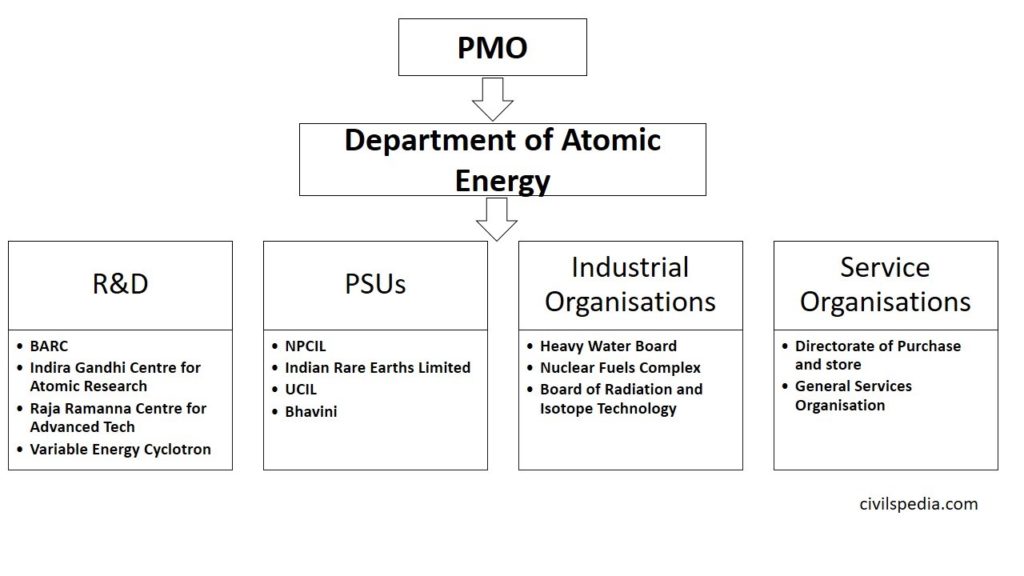Table of Contents
Indian Nuclear Sector
This article deals with ‘Indian Nuclear Sector.’ This is part of our series on ‘Science and Technology’ which is important pillar of GS-3 syllabus . For more articles , you can click here
Aim of the nuclear research in India
- Peaceful use of the nuclear energy
- Power generation
- Applications in the agriculture
- Medical sciences, industrial application etc
Organisational set up

Department of Atomic Energy( DAE)
- Formed in 1954
- Headquarters – Mumbai
- Directly under PMO
- Responsible for the Nuclear energy including nuclear power and research
Atomic Energy Regulatory Board( AERB)
- Setup in 1983
- Under Atomic Energy Act ,1962
- For regulating nuclear sector
Some institutions running under DAE
1.R&D sector
BARC
- Bhaba Atomic Research Centre
- Headquartered in Bombay
- Formed in 1954 in Trombay (Mumbai)
- Involved in research and development (R&D) in the field of Nuclear Energy.
- Made research reactors like Apsara (1956), Zerlina (1961) etc
IGCAR(Indira Gandhi Centre for Advanced Research)
- Headquartered in Kalpakkam
- Formed in 1981
- Made various reactors for producing energy . Eg Tarapur (1969), Rawatbhata (1981) etc
- Currently working on PFBR (2nd Stage Reactor)
Raja Ramanna Centre for Advanced Technology
- Situated in Indore
- Doing work in advanced technology like Atomic Energy , Nano Tech, robotics etc
Variable Energy Cyclotron Centre
- Situated in Kolkata
Atomic Minerals Division (AMD)
- Situated in Hyderabad
- Looks after availability of Nuclear Fuels in India
2. Public Sector Undertakings
NPCIL (Nuclear Power Corporation of India Ltd)
- Situated in Mumbai
- Incharge of First stage of Nuclear Plants
- All 24 Nuclear Energy Plants in India are working under it
BHAVINI
- Bhavini = Bhartiya Nuclear Vidyut Nigam Limited
- Situated in Kalpakkam
- incharge of second stage -> PFBR operated by it
Uranium Corporation of India ltd (UCIL)
- Situated in Jaduguda
- Extract Uranium and process it to yellow cake
Indian Rare Earth ltd
- Situated in Mumbai
3. Industrial sector
| Heavy Water Board | Mumbai |
| Nuclear Recycling Board | Mumbai |
| Nuclear Fuel Complex | Hyderabad |
| Board of Radiation and Isotope Technology | Mumbai |
4. Aided institutions
| TIFR (Tata Institute of Fundamental research) | Bombay |
| Tara Memorial Centre | Bombay |
| Saha Institute of Nuclear Physics | Kolkata |
| Institute of Physics | Bhubaneswar |
| Institute of the Mathematical sciences | Madras |
India and Atomic Bomb
- Indian Government formed Department of Atomic Energy (DAE) post independence which has conducted 2 successful Nuclear tests till date
| 1st | May 1974 | Smiling Budha | Based on Nuclear Fission |
| 2nd | May 1998 | Shakti | Both Nuclear Fission and Fusion (Hydrogen bomb) |
- Indian Nuclear Program is
considered better than rest of nuclear powers of the world because
- India has adopted ‘No First Use Policy’ .
- Indian Atomic Bombs are under Civilian Government.
- Indian Nuclear Bombs are of minimal capacity of destruction .
